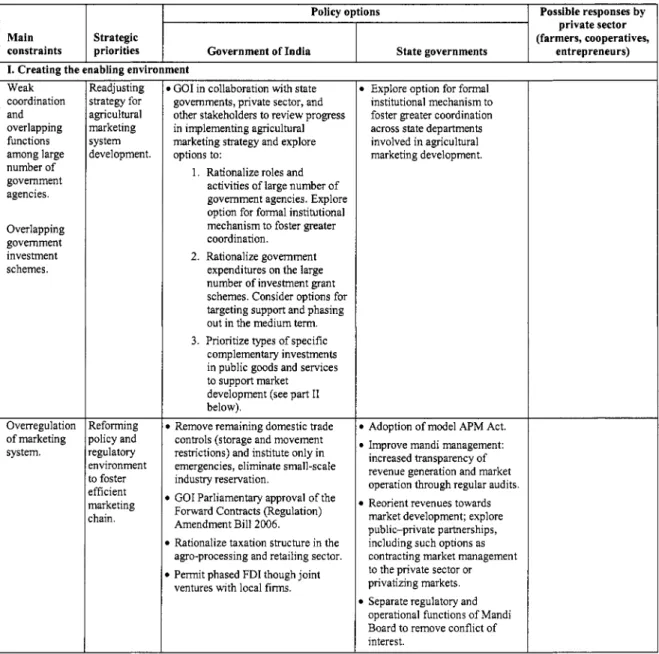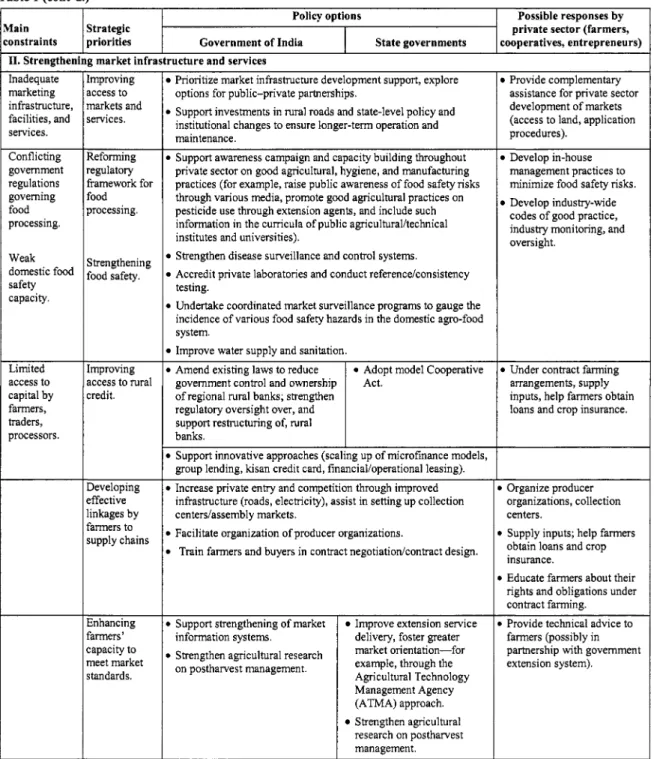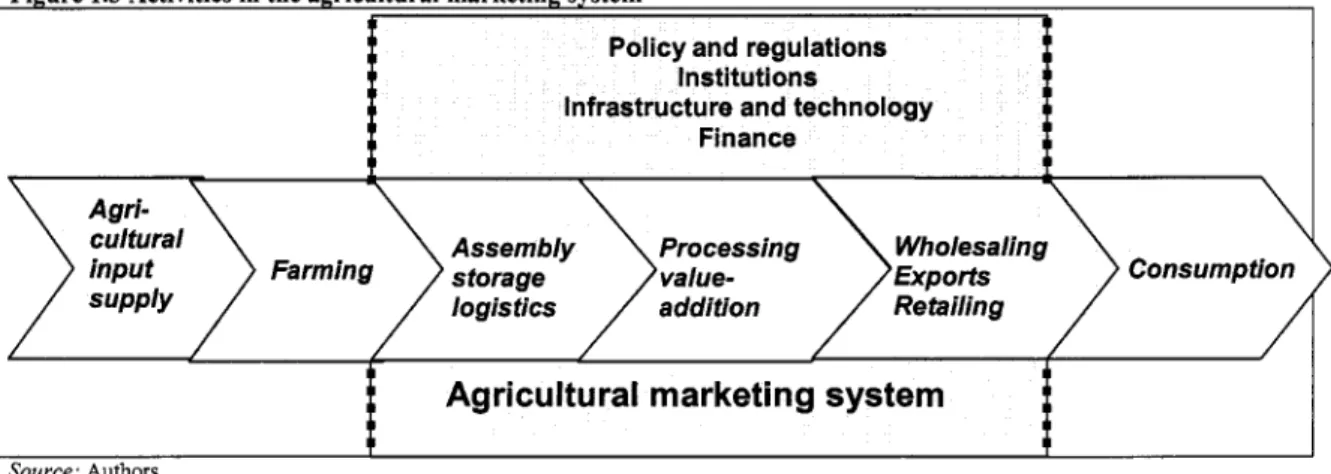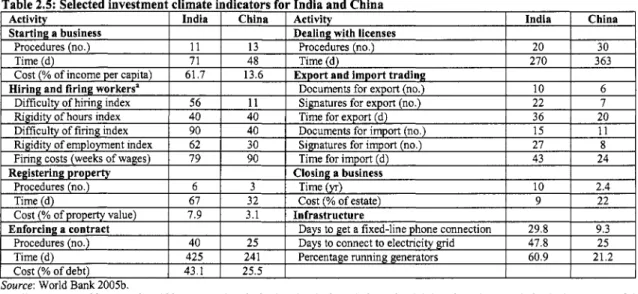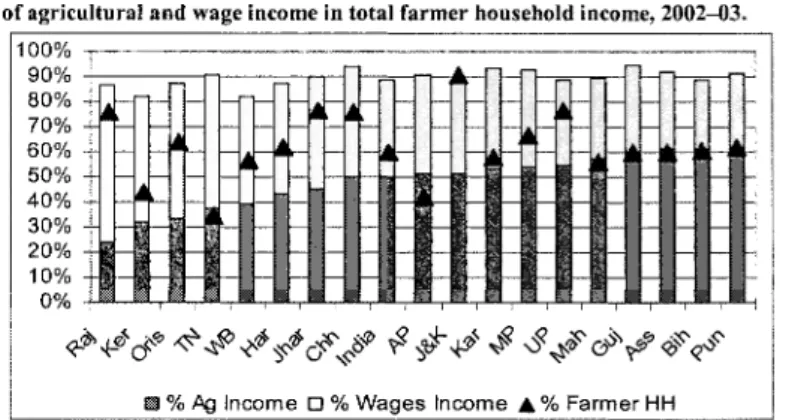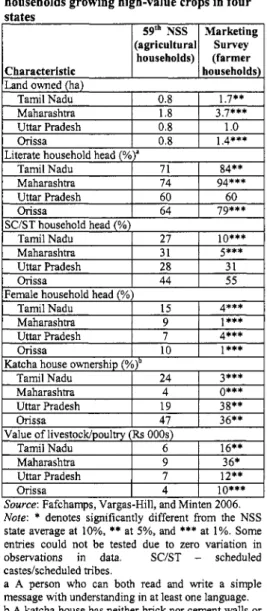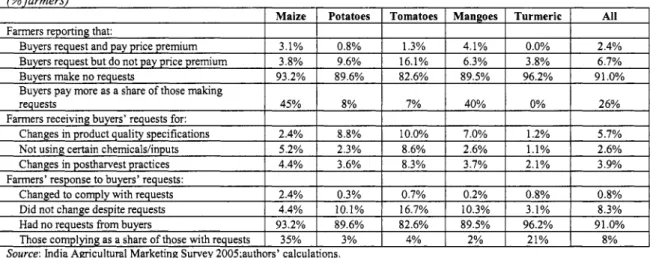October 17, 2008
Document of the World Bank
Report No. 35953-IN India Taking Agriculture to the Market
Report No. 35953-IN
India
Taking Agriculture to the Market
Agriculture and Rural Development Unit
South Asia Sustainable Development Department South Asia Region
Public Disclosure AuthorizedPublic Disclosure AuthorizedPublic Disclosure AuthorizedPublic Disclosure Authorized
INDIA
Taking Agriculture to the Market
Contents
Acronyms and Abbreviations ... ii
Acknowledgments ... vii
Executive Summary ... i x I . Introduction ... 1
A . Overview ... 1
B . Challenges in the Agricultural Marketing and Processing Systems ... 3
I1 . Policy Environment for Agricultural Marketing and Processing in the 1990s ... 5
B . Taxation o f the Agricultural Marketing System ... 11
C . A . Liberalizing Agricultural Marketing ... 6
Investment Climate ... 12
D . Ministries and Agencies Involved with Agricultural Marketing and Processing ... 12
I11 . Linking Farmers to the Market ... 19
A . Characteristics o f Farmers Growing High-Value Crops ... 19
B . Farmers’ Access to Markets ... 2 1 C . Farmers’ Access to Market and Other Information ... 23
D . Postharvest Activities Performed by Farmers to Enhance Quality ... 23
E . Contract Farming: Status and Challenges ... 25
F . Other Marketing Arrangements ... 27
G . Farmers’ Participation in Producer Groups ... 28
I V . Trading in Agricultural Commodities ... 31
Access to Wholesale Markets ... 31
D . Food Retailing ... 41
A . B . Trading in Wholesale Markets ... 37
C . Investment Climate in Wholesale Trading ... 40
E . Domestic Grades and Standards ... 45
V . Value-Addition and Export of High-Value Agricultural Products ... 47
B . Marketing Operations o f Agro-Processors and Exporters ... 49
A . Recent Performance o f t h e A g o - F o o d Processing Sector ... 47
C . Recent Agricultural Export Performance ... 50
D . SPS Standards and Indian Horticultural Exports ... 52
V I . Fostering an Efficient and Competitive Agricultural Marketing System: Policy Options ... 61
A . Creating the Enabling Policy Environment ... 63
B . Expanding Market Infrastructure and Services ... 65
C .
D . Strengthening Capacity t o Manage SPS Standards ... 77
E . Conclusion ... 80
Strengthening Farmer Linkages to the Market ... 71
References ... 82
Annex A:India Agricultural Marketing Survey ... 9 1 Annex B:Economic Considerations in Agricultural Marketing ... 97
Annex C:Using Negotiable Warehouse Receipts ... 98
Annex D:India’s Emergent Horticultural Exports: Addressing SPS and Other Challenges ... 99
Annex Tables ... 104
Annex Figures ... 93
Table 1 Table 1 . 1 Table 2.1 Table 2.2 Table 2.3 Table 2.4 Table 2.5 Table 2.6: Table 2.7 Table 3.1 Table 3.2 Table 3.3 Table 3.4 Table 3.5 Table 3.6 Table 3.7 Table 4.1 Table 4.2. Table 4.3 Table 4.4 Table 4.5 Table 4.6 Table 5.1 Table 5.2 Table 5.3 Table 5.4 Table 5.5 Table 5.6 Table 6.1 Table 6.2 Table 6.3 Tables Fostering efficient and competitive agricultural marketing systems: Policy options .. xiv
Agricultural growth rate in major states. 1985/8fL2002/03 ... 1
Major GO1 agncultural marketing policy reforms. 1998/99-2005/06 ... 6
Implementation o f the Agricultural Produce Marketing A c t in selected states ... 7
Major domestic policy and trade regulations at the central and state levels. 1996 and 2006 ... 10
Tax reforms in the agricultural and food processing sector ... 11
Selected investment climate indicators for India and China ... 12
Government agencies involved in promoting agncultural marketing and ago-industry Major agncultural marketing and ago-industry investment grant schemes for the Selected characteristic o f households growing high-value crops in four states ... 2 1 Major marketing channels for cereals and agncultural produce ... 22
Sales destination o f farmers’ produce ... 22
Wholesale market improvements requested by farmers ... 23
Farmer sources o f information ... 24
D o traders reward farmers for quality-enhancing measures? ... 25
Type, location, and size o f markets ... 32
Traders’ credit sources ... 38
Marketing margins f r o m trading ... 40
Supermarkets’ share in food retail, selected countries ... 42
Examples o f organized, privately owned retail chains in India ... 43
Characteristics o f processors and exporters ... 49
Source o f capital by type o f enterprise ... 49
Major destinations o f Indian agricultural exports, 2004 ... 51
Major impacts and emerging challenges o f SPS measures for Indian horticultural exports ... 53
Unit value variations between markets applying higher and lower SPS standards ... 53
Estimated annual cost o f meeting SPS standards in the EU in 2005 ... 56
Economic characteristics and performance mechanisms for agncultural marketing activities ... 63
Developing rural/wholesale markets: Key planning processes ... 68
Public activities to improve food safety ... 69
development ... 14
private sector, 2005 ... 16
Examples o f successful contract farming initiatives ... 26
Traders’ access to shops/stalls in wholesale markets ... 36
Table 6.4 Table 6.5 Table 6.6
Figure 1.1 Figure 1.2 Figure 1.3 Figure 2.1 Figure 3.1 Figure 3.2 Figure 4.1 Figure 4.2 Figure 4.3 Figure 4.4 Figure 4.5 Figure 4.6 Figure 4.7 Figure 4.8 Figure 4.9 Figure 5.1 Figure 5.2 Figure 5.3 Figure 6.1
B o x 2.1 B o x 3.1 B o x 5.1 B o x 6.1 B o x 6.2 B o x 6.3 B o x 6.4 B o x 6.5
Table A l . l
Public and private options for strengthening farmers’ linkages to the market ... 72
Actors in strategic response to standards ... 79
Public and private sector roles in enhancing trade-related SPS and quality management capacity ... 80
Figures Diversification in food consumption ... 2
Trends in agncultural exports. triennium Ending (TE) 1990/91 t o TE 2003/04 ... 3
Activities in the agricultural marketing system ... 4
Facilities available in regulated markets handling high-value products in Maharashtra. Orissa. Tamil Nadu. and Uttar Pradesh. 2005 ... 8
Percent share o f farmer households in rural households and share o f agricultural and wage income in total farmer household income. 2002-03 ... 20
Farmers’ membership in producer groups by crop and state ... 29
Wholesale market density (2003) and distance to wholesale markets in focus states (2005) ... 32
Distribution o f wholesale markets by area ... 33
Limited infrastructure in wholesale markets ... 33
Marketing services provided in wholesale markets ... 35
Facilities and equipment in market stalls ... 35
Estimated produce losses in wholesale markets ... 37
Estimated marketing costs in fruit and vegetable supply chains. India and the U S A ... 39
Constraints in the investment climate for agricultural trading in Onssa. Uttar Pradesh. Maharashtra. and Tamil Nadu ... 40
Sales in the organized food retail sector. India. 2001/02-2007 ... 41
Food processing levels in India ... 48
M a i n constraints to agricultural processors and exporters ... 50
Trends in agricultural exports. 1987/99-2003/04 ... 5 1 Impact o f rural roads improvement o n the rural economy in Andhra Pradesh. 1997 ... 70
Boxes Salient features o f the model Agncultural Produce Marketing (Development and Regulation) A c t 2003 ... 9
Direct marketing through the e-choupal ... 28
Framework for an ex ante assessment o f costs and benefits o f sanitary and phytosanitary (SPS) compliance ... 58
Role o f government in agncultural marketing and agnbusiness development ... 64
Private contract enforcement and self-enforcing contracts ... 74
Supermarkets: Sourcing produce from small-scale farmers ... 75
Agricultural Technology Management Agency (ATMA) scheme ... 77
Market intelligence and women producers in Bangladesh ... 78
Annex Tables Number o f respondents by crop ... 92
Table A l . 2 Number o f respondents by state ... 92
Annex table 2.1 State-level progress in adopting model APMC Act. as o f October 2005 ... 104
Annex table 2.2 Incidence o f market cess and sales and other taxes levied in 105
different states. 2002 ... 105
Annex table 2.3 Agncultural marketing schemes for the private sector: Provisions for government support ... 106
Annex table 3.1 Selected characteristics o f households growing high-value crops ... 110
Annex table 3.2 Farmers’ sources o f credit ... 110
Annex table 3.3 Constraints to increased high-value crop production ... 110
Annex table 3.4 Postharvest operations performed by farmers ... 111
Annex table 3.5 Determinants o f postharvest practices to improve quality ... 112
Annex table 4.1 Wholesale market revenues in Tamil Nadu. Ollssa. Maharashtra. and Uttar Pradesh. 2005 ... 113
Annex table 4.2 U s e o f auctions in wholesale markets ... 113
Annex table 4.3 Information provided before the auction ... 114
Annex table 4.4 Market associations and dispute resolution ... 114
Annex table 4.5 Determinants o f crop losses in wholesale markets ... 114
Annex table 4.6 Socioeconomic characteristics o f traders ... 115
Annex table 4.7 Determinants o f marketing margins ... 115
Annex table 5.1 Distribution o f processors and exporters surveyed ... 116
Annex table 5.2 Role o f quality in processors’ and exporters’ transactions ... 116
Annex Figures Figure A l . l Figure A1.2 Figure A1.3 Figure A1.4 Figure C1.l Location o f sampled markets in Orissa ... 93
Location o f sampled markets in Maharashtra ... 94
Location o f sampled markets in Uttar Pradesh ... 95
Location o f sampled markets in Tamil N a d u ... 96
Warehouse receipt financing: Process flow ... 98
Annex figure 2.1 Annex figure 3.1 Annex figure 4.1 Annex figure 4.2 Annex figure 4.3 Annex figure 4.4 Annex figure 4.5 Annex figure 4.6 Annex figure 4.7 Annex figure 5.1 Cold storages established under NHB C o l d Storage Scheme. 1999/2000 to January 2005 ... 117
h g a t i o n use for tomatoes. potatoes. mangoes. maize. and turmeric in Tamil Nadu. Maharashtra. Uttar Pradesh. and Orissa ... 117
Distribution o f wholesale markets by age in Tamil Nadu. Orissa. Maharashtra. and Uttar Pradesh ... 118
Warehouse capacity in India. 2004 ... 118
Cold storage capacity in India. 2004 ... 118
M a i n causes o f market disputes ... 119
Trade credit by traders ... 119
Sources o f price and market information for traders ... 120
Constraints to agncultural trading in Orissa. Uttar Pradesh. Maharashtra. and Tamil Nadu ... 121
Constraints to ago-processors and exporters in Orissa. Uttar Pradesh. Maharashtra. and Tamil Nadu ... 122
Acknowledgements
This report was prepared by a team l e d by D i n a Umali-Deininger, under the overall guidance o f Adolfo Brizzi, Sector Manager and Gajanand Pathmanathan, Operations Manager.
M a j o r contributors to the report are: Forhad Shilpi, Xiangping Liu, Marcel Fafchamps, Ruth Vargas- Hill, Bart Minten, J.B. Singh, Social and Rural Research Institute (India) (state agricultural marketing survey data collection and analysis); M o n a Sur, Steven Jaffee, K e l l y Jones (sanitary and phytosanitary issues), Niraj Venna (rural credit), and Gokul Patnaik (agricultural marketing policy review). T h i s report also draws from a companion W o r l d Bank study, “India’s Emergent Horticultural Exports: Addressing SPS and Other Challenges” (World Bank 2007). Administrative support was provided by Sarita Rana, Jai Mansukani and Lilac Thomas. The report was edited by Alicia H e t n e r .
The team especially wishes to thank the peer reviewers, Sushma Ganguly, Richard Henry, and Gershon Feder, for their valuable guidance and advice during the preparation o f the report and Priya Basu, Robert Epworth, Rabih Karaky, Deepak Mishra, Martien van Nieuwkoop, and Fayez Omar for their helpful comments
W e gratefully acknowledge the valuable cooperation and generous assistance provided by officials from the Ministries o f Agriculture, Food Processing Industries, and Commerce; the Departments o f Agriculture and Marketing and Cooperation; the respective State Agricultural Produce Marketing Boards in Orissa, Uttar Pradesh, Maharashtra and Tamil Nadu. W e thank a l l the fanners, traders, and other entrepreneurs in these states who gave their time to participate in the focus discussions and marketing surveys. W e also thank the UK Department for International Development (DfID) and the W o r l d Bank P S I A group for the financial support they provided in undertalung the state agricultural marketing surveys.
This report has been discussed with the Government o f India, but does not necessarily represent their views or bear their approval for all i t s contents.
Executive Summary
Overview
Policy makers in India recognize the importance o f well-functioning markets to agricultural growth, food security, and broad-based rural development. Markets facilitate the commercialization and diversification o f farming, and they are essential for efficiently bringing food and agricultural products to domestic and international consumers. W e l l functioning domestic markets can reduce the cost o f food and assure stability o f supply, which as the recent global food crisis has highlighted, are key to assuring the food security o f poor and non-poor households. They also open opportunities for greater value-addition and employment throughout the economy. In this regard, the Prime Minister o f India, Dr. Manmohan Singh, noted during the Agriculture Summit 2005 in N e w D e l h i that “an important commitment o f the government i s to integrate the domestic market t o all goods and services. The time has come for us to consider the entire country as a common or single market for agricultural products. W e have to systematically remove a l l controls and restrictions.. . .”
The rapid growth o f the Indian economy i s bringing n e w forces for change in agncultural marketing and processing systems. Changes in consumer demand are fueled by rising incomes, increasing urbanization, a growing middle class demanding more diversified and higher-quality food, more working women demanding access to prepared or processed foods and more convenient shopping under one roof, and increased exposure to products through wider media penetration (domestic and international television, cable, and internet). These forces in turn drive changes in the structure o f marketing and encourage agricultural diversification.
Critical weaknesses have been exposed in the agncultural marketing system as a result o f these rapidly evolving domestic and international developments. For most commodities, the agncultural marketing system-defined broadly to include physical assembly, handling, storage, transport, processing, wholesaling, retailing, and export o f agncultural commodities and associated infrastructure and support services-remains fragmented and uncoordinated, subject to multiple layers o f intermediaries, with markets that have inadequate infrastructure and facilities, and supply chains subject to high wastage and losses. In addition, the tighter international sanitary and phytosanitary (SPS) standards promulgated by governments and the private sector constitute an additional hurdle for India’s agricultural exports to overcome.
Experiences in many developed countries (in the USA and OECD, for example) and developing countries (such as Brazil, China, Indonesia, Malaysia, and Thailand) illustrate a natural evolution in h o w agricultural marketing systems are organized and managed. This evolution i s driven by changing socioeconomic conditions resulting from urban growth, rising consumer incomes, concerns about quality and food safety, increased agro-processing, and improved infrastructure and services. While the traditional marketing structure-in which fresh agncultural produce moves from farms to rural assembly/primary wholesale markets, secondary wholesale markets, retail markets, and finally t o consumers-may persist, new forms o f coordinated supply chains may emerge, owing to the economic and competitive need t o reduce logstical costs, meet consumers’ rising demand for more value-added products, and at the same time address consumers’
concerns about convenience, quality, and food safety. As noted, such forces for change are becoming evident in India.
The development o f efficient and competitive marketing systems in India that can effectively respond to these domestic and global changes will require action o n a number o f fronts in the short to medium term. Given the important roles o f the public and private sector in developing the agricultural marketing system, at this juncture the government needs to reorient i t s strategy to focus on:
Continuing reforms in the policy and regulatory environment to eliminate the remaining obstacles to more effective market operations and the development o f more efficient supply chains.
Rationalizing the roles and activities o f the large number o f government agencies involved in agncultural marketing development to foster greater coordination, build synergies, eliminate duplication o f effort, and increase the focus o n facilitation and regulation rather than direct intervention.
Reviewing and rationalizing public expenditures in the sector. Public expenditures should focus increasingly o n financing public goods and services (such as markets, market information and extension, food safety, complementary rural infrastructure, and capacity building) that facilitate increased private sector participation. The numerous grant schemes designed to foster private sector investment should be reviewed and rationalized to eliminate duplication and maximize impact.
0
Policy and Regulatory Environment: Remaining Steps
Complete the deregulation of the agricultural marketing system. Since the late 1990s, the Government o f India (GOI) has implemented a vast array o f policy reforms that have hastened the growth and development o f the agricultural marketing system. The next steps in moving forward are to permanently remove storage and movement restrictions o n all commodities and enforce them only during emergencies, eliminate the small-scale industry reservation o n the remaining agro-industrial activities, and allow phased entry o f foreign direct investment (FDI) in food retailing (for example, through j o i n t ventures with local companies) (table 1). Parliamentary approval o f the Forward Contracts (Regulation) Amendment Bill 2006, which will remove the ban o n trading o f commodity options, will be critical milestones.
Nationwide adoption o f the model Agricultural Produce Marketing (APM) A c t i s an equally crucial milestone in the reform process. Broad-based adoption o f the model A c t i s essential for building an integrated national market, which to date has been adopted by only 15 states and union territories. But institutional reforms within the M a n d i complex are also necessary t o improve the management and quality o f services provided by the regulated market network. Such reforms could include subcontracting market management to the private sector or privatizing markets. The M a n d i Board could concentrate o n planning and o n regulating the wholesale marketing network, thus eliminating the conflict o f interest that currently arises when it acts as both operator and regulator.
The removal o f storage and movement controls will also enable India’s commodity futures markets t o operate more effectively. These markets could play an important role in enabling farmers to hedge their price r i s k s in the context o f a more liberalized market.
Rationalize the tax structure governing wholesaling, retailing and agro-processing. Changes in the tax structure will improve the incentives for private sector investments and participation. The adoption o f VAT by state governments helped considerably in reducing the impact o f cascading state taxes across the agricultural supply chain, but the central excise tax o n a large number o f processed agncultural and food products remains high. This tax increases the cost to consumers and reduces the competitiveness o f Indian products overseas.
Complete the unfinished agenda for rationalizing the roles of government agencies. As mentioned, a multiplicity o f government agencies are involved in the agricultural marketing system.
Functions and schemes overlap significantly. At least 39 central government agencies promote agncultural marketing development, either broadly or with respect to specific commodities. Most o f these agencies offer investment grants to the private sector, but weak coordination o f these efforts prevents greater synergies in development impact and in some instances leads to duplication. For example, three government ministries offer grants t o invest in cold storage facilities; each grant scheme has different terms and conditions. Clearly these schemes should be rationalized. Greater
coordination should be fostered among the agencies that implement them to promote greater consistency, minimize duplication, more effectively track the level o f support, and document the impact o f these investments..
Rationalizing Public Investments in Agricultural Marketing: Towards a New Paradigm
Improve market infrastructure and services. The limited accessibility and inadequate facilities o f existing markets are major constraints to efficient operation. In the medium term, i t i s expected that a large share o f agricultural produce will continue to f l o w along traditional marketing channels. The continuing pressure o n these traditional channels highlights the need t o fill the significant gap in market infrastructure. Efforts over the longer term, however, have to b e framed within a holistic agricultural market development strategy. In formulating a development plan to expand market infrastructure, two major issues are o f concern. First, in assessing infrastructure needs, a comprehensive assessment o f current and future marketing needs (that is, growth in production and demand, expected volumes o f marketed throughput, and product quality standards), nationally and at the state level, i s required. T h i s assessment will necessarily involve carefbl consideration o f factors dnving the development o f alternative marketing arrangements t o meet diverse and rapidly changing local needs, such as direct purchase, contract farming, and vertical integration trends. Market development, therefore, may call for a range o f options, from setting up village or district-level markets, rural hubs, to establishing general or specialized wholesale markets or terminal markets, to facilitating the development o f more direct marketing arrangements. Second, careful consideration i s required as to whether the government or private sector should take the lead in implementing the various market development activities.
Improving the operations and facilities o f regulated markets requires a closer review o f h o w the regulated market system i s managed, and particularly o f h o w it uses the significant revenues generated from the marketing cess and other fees. It will be critical to ensure that more o f these resources are used to improve market facilities (for example, to provide price information systems, adequate shops, parlung, drainage, improved roads, security within the market, public toilets, canteens, and hostels for farmers). Greater transparency regarding the actual revenues generated by the mandi system and the allocation o f expenditures i s critical. The annual audit o f accounts and their public disclosure should become mandatory for all M a n d i Boards.
Strengthen grades and standards and food safety. While grades governing the quality o f agncultural produce function best if adopted voluntarily, as they are set primarily to facilitate trade and are not a regulatory instrument, standards for food safety should be mandatory. The public sector has a critical role to play in ensuring food safety, not only in terms o f policy malung and regulation, but also in providing information and training (for example, information on international standards o r risk assessment training), key infrastructure for prevention and control (such as laboratories for disease monitoring and surveillance or food testing), and research (for example, to develop hazard control strategies).
Improve access to credit. Poor access to credit i s cited by farmers, traders, processors, and exporters as a major constraint t o their production and marketing activities. Policy actions that could improve access to credit encompass a number o f areas, including: legal and regulatory reforms and restructuring o f rural banks, and broader adoption o f innovative products, such as group lending, lusan credit cards, and financial and operational leasing. Policy reforms are needed to improve the overall regulatory and legal framework for rural finance, in particular for rural banks and rural credit cooperatives. Priority areas for action include: (1) enhancing the regulatory oversight and supervision based o n internationally accepted prudential norms; (2) reducing government control and ownership (for regional rural banks this would require an amendment o f the existing law, and for rural cooperatives it would require state governments to adopt the model Cooperatives Law); (3) strengthening corporate governance and improving management and staff slulls, particularly in credit decisions and risk assessment and management; and (4) strengthening the legal framework to make i t
easier for regional rural banks and credit cooperatives to recover small loans and to facilitate the use o f land as collateral.
Strengthen rural road connectivity. Public investment in rural roads, by increasing rural connectivity, can have a significant impact on farmers’ access to markets, the development o f supply chains, and overall marketing efficiency, in addition to other beneficial impacts o n rural households.
In implementing the Bharat Nirman, i t will b e important for the Ministry o f Rural Development (MoRD) to take the lead in implementing essential policy and institutional changes as w e l l as in financing, technology transfer, human resource development, and monitoring o f rural road development in different states. Panchayat Raj bodies at the district, block, and village levels can play a pivotal role in the construction and management o f rural roads. Community participation offers significant potential for mobilizing the support o f local communities in generating resources, acquiring land, and tailoring rural road programs to local needs.
Strengthening Farmers’ Linkages to the Supply Chain
Contract farming and supermarket procurement arrangements are two supply chain arrangements that are gaining ground amid active debate in India. While there i s growing appreciation, especially among entrepreneurs engaged in agricultural trade and agro-processing, of the potential benefits o f more coordinated supply chains, an important concern i s whether small- scale farmers can equally benefit from these arrangements. International experience provides useful lessons for fostering greater inclusion o f small-scale farmers. Notably, many o f the lessons emerging from this experience, such as successful approaches for strengthening farmers’ bargaining ‘power or improving their technical capacity to meet consumers’ product and quality requirements, are equally relevant for farmers who market produce through traditional channels.
Recent experience in India indicates that contract farming and supermarket procurement approaches will have to involve small-scale farmers in the medium term, because the farm structure obliges them to do so. Experience in several countries in East Asia and L a t i n America shows that land will not be the most important determinant o f participation; individual capitalflabor ratios and access to public infrastructure will be more important. The small-scale farmers who are “rich” in financial and human capital assets will be able to participate in the demanding n e w supply chains, which highlights the importance o f improving farmers’ range o f assets to meet the n e w requirements o f more coordinated supply arrangements.
Approaches to promote equitable participation by large- and small-scale farmers include:
(1) facilitating entry and competition among buyers (for example, improving the rural infrastructure or establishing collection centers to reduce the transaction costs involved in sourcing f r o m small- scale farmers); (2) organizing farmers into formal or informal groups to meet the volume requirements and strengthen farmers’ bargaining power; (3) enhancing farmers’ capacity to adopt improved production and postharvest techniques to meet the required higher quality standards;
(4) assisting farmers to obtain the capital to make on-farm improvements and other required investments (for example, in irrigation, greenhouse, grading, or cooling facilities) and acquire essential national and international certifications; (5) training farmers and buyers about their rights and obligations under contract farming arrangement and in the design o f contracts; and (6) developing institutions that assist farmers to settle contract disputes (such as commodity or market associations). In some countries, public-private partnerships have been instrumental to the success o f new supply chain arrangements (for example, in providing extension and technical assistance to improve the quality and safety o f produce and accreditation o f farmers).
T h e Ministry o f Agriculture’s AGMARKNET program, which collects selling prices at regulated markets and disseminates them through the Internet, i s improving access to real-time price information by market users. In the future, this program could be expanded to include information from nonregulated markets. Innovative ways o f connecting to these databases using advances in
communications technology (dial-up services, mobile phones, or rural luosks) could be explored.
Strengthening the public and private extension system can play an important role in helping farmer access to production and market information. A number o f private firms in India offer extension services to farmers, although these generally are linked to input supply or output purchasingkontract farming arrangements. The public extension system, o n the other hand, i s falling behind. I t must be reoriented away f r o m traditional supply-driven, production-focused approaches and towards more market-oriented approaches. Delivery o f public extension services could be improved by introducing decentralized strategic planning, with the active participation o f farmers and other stakeholders.
Strengthening Capacity to Meet Sanitary and Phytosanitary (SPS) Standards
There i s a need for the government t o move towards a more cost-effective and strategc approach to SPS standards. Such an approach would involve placing somewhat less emphasis o n mandatory controls, inspections, and testing and considerably more emphasis o n promoting agro- food system stakeholder awareness about SPS management; developing and promoting adoption o f good practices (such as good agricultural practices, good manufacturing practices, and hazard analysis and critical control point systems) throughout the supply chain; and facilitating effective individual and collective action by private firms, farmers, service providers, and others. I t i s often assumed that the management o f food safety and a p c u l t u r a l health i s predominantly the responsibility o f the public sector. Indeed, many critical regulatory, research, and management functions are normally carried out by governments, and in a variety o f circumstances importing countries require that certain functions, such as export certification, be performed by a designated
“competent authority” in the public sector. However, the private sector can also play an important role in setting standards and in actual compliance with food safety and agricultural health requirements. Capacity building in the private sector can complement (or even substitute for) public sector capacity, such as the investment in accredited laboratory testing facilities.
Conclusion
India’s rural development strategy faces the challenge o f meeting rapidly changing needs in rural areas, nationwide, and globally. Concurrent rapid growth in the a p c u l t u r a l and rural nonfarm sectors i s an integral and important part o f overall economic development, because these sectors jointly, directly, and indirectly help generate opportunities for greater employment and income growth. Removing policy and regulatory barriers so that those who choose to remain in agriculture can enhance their productivity and competitiveness and achieve the highest returns from their endeavors i s critical for maximizing the agricultural sector’s contribution to overall economic growth. I t i s particularly important because the majority o f India’s workforce remains dependent o n apculture. At the same time, growth in the rural nonfarm sector (industry and services) will not only offer alternative employment opportunities but will create a strong foundation for consumer demand in rural areas. An increase in rural-based demand can, in tum, stimulate growth in the agricultural and other sectors o f the economy. Achieving such broad-based growth, however, will require vigilant adjustment to rapidly changing market opportunities and challenges, internally and globally.
A dynamic apbusiness sector and agricultural markets that integrate rural areas into the state and national economy will be important drivers for agricultural and rural growth, food security, and rural poverty reduction in India. As noted in the 10” Five Year Plan, fostering an efficient and competitive a p c u l t u r a l marketing system i s indispensable for the overall development o f the country’s economy. International experience shows that modern and efficient agncultural marketing systems and the consequent improvements in competitiveness are crucial catalytic forces for directly and indirectly promoting growth and poverty reduction. Modern marketing systems reduce the cost o f food, reduce supply uncertainties, and improve the diets o f the poor and non-poor in urban and rural areas. In opening greater opportunities for farmers and other entrepreneurs, they help generate
employment and consequently raise and diversifL income potential in rural and urban areas. Finally, they enhance farmers' incentives to increase productivity and link more closely into local, national, and international markets. India has made great strides in the last five years in improving the environment for an efficient and competitive agricultural marketing system to grow and develop.
The challenge n o w i s to sustain this momentum over the medium to longer term, so that the agncultural sector and society as a whole can truly capture the multiple benefits o f well-functioning and efficient agricultural marketing systems.
M a i n Strategic constraints priorities
Table 1 : Fostering efficient and competitive agricultural marketing systems: Policy options
Policy options Possible responses by
private sector (farmers, cooperatives, Government of India State governments entrepreneurs)
Weak coordination and overlapping functions among large number o f government agencies.
Overlapping government investment schemes.
Overregulation o f marketing system.
Zeadjusting trategy for igricultural narketing ystem levelopment.
Leforming iolicy and egulatory nvironmen t 3 foster fficient narketing hain.
GO1 in collaboration with state governments, private sector, and other stakeholders to review progress in implementing agricultural marketing strategy and explore options to:
1. Rationalize roles and activities o f large number o f government agencies. Explore option for formal institutional mechanism to foster greater coordination.
expenditures on the large number o f investment grant schemes. Consider options for targeting support and phasing out in the medium term.
3. Prioritize types o f specific complementary investments in public goods and services to support market development (see part I1 below).
2. Rationalize government
Remove remaining domestic trade controls (storage and movement restrictions) and institute only in emergencies, eliminate small-scale industry reservation.
GO1 Parliamentary approval o f the Forward Contracts (Regulation) Amendment Bill 2006.
Rationalize taxation structure in the ago-processing and retailing sector.
Permit phased FDI though joint ventures with local firms.
' Explore option for formal institutional mechanism to foster greater coordination across state departments involved in agricultural marketing development.
Adoption o f model AF'M Act.
Improve mandi management:
increased transparency o f revenue generation and market operation through regular audits.
Reorient revenues towards market development; explore public-private partnerships, including such options as contracting market management to the private sector or privatizing markets.
Separate regulatory and operational functions o f M a n d i Board to remove conflict o f interest.
Table 1 (cont’d.) fain
onstraints
Policy options Possible responses by
Strategic private sector (farmers,
priorities Government of India State governments cooperatives, entrepreneurs)
Inadequate marketing infrastructure, facilities, and services.
Conflicting government regulations governing food processing.
Weak domestic food safety capacity.
Limited access to capital b y farmers, traders, processors.
Improving access to markets and services.
Reforming regulatory framework for food processing.
Strengthening food safety.
Improving access to rural credit.
Developing effective linkages b y farmers to supply chains
Enhancing farmers’
capacity to meet market standards.
hioritize market infrastructure development support, explore options for public-private partnerships.
m Support investments in rural roads and state-level policy and institutional changes to ensure longer-term operation and maintenance.
D Support awareness campaign and capacity building throughout private sector on good agricultural, hygiene, and manufacturing practices (for example, raise public awareness o f food safety risks through various media, promote good agricultural practices on pesticide use through extension agents, and include such information in the curricula o f public agriculturaVtechnica1 institutes and universities).
Strengthen disease surveillance and control systems.
Accredit private laboratories and conduct reference/consistency testing.
* Undertake coordinated market surveillance programs to gauge the incidence o f various food safety hazards in the domestic ago-food system.
Improve water supply and sanitation.
government control and ownership o f regional rural banks; strengthen regulatory oversight over, and support restructuring of, rural banks.
group lending, kisan credit card, financiaVoperationa1 leasing).
m Support innovative approaches (scaling up o f microfinance models,
e Increase private entry and competition through improved infrastructure (roads, electricity), assist in setting up collection centerdassembly markets.
m Facilitate organization o f producer organizations.
m Train farmers and buyers in contract negotiatiodcontract design.
* Support strengthening o f market information systems.
* Strengthen agricultural research on postharvest management.
Improve extension service delivery, foster greater market orientation-for example, through the Agricultural Technology Management Agency (ATMA) approach.
Strengthen agricultural research on postharvest management.
Provide complementary assistance for private sector development o f markets (access to land, application procedures).
Develop in-house management practices to minimize food safety risks.
Develop industry-wide codes o f good practice, industry monitoring, and oversight.
Under contract farming arrangements, supply inputs, help farmers obtain loans and crop insurance.
1 Organize producer organizations, collection centers.
1 Supply inputs; help farmers obtain loans and crop insurance.
1 Educate farmers about their rights and obligations under contract farming.
t Provide technical advice to farmers (possibly in partnership with government extension system).
Table 1 (cont’d.)
Policy options Main Strategic
constraints priorities Government o f India State governments
Possible responses by private sector (farmers, cooperatives, entrepreneurs)
Weak capacity to meet tightening international SPS standards.
- . ~
nfluencing hies o f tl;e :ame.”
strengthening :apacity for :ompliance.
and multilateral dialogue and periodic negotiations to address emerging constraints or opportunities related to SPS issues.
Support awareness campaign and capacity building o f private sector on good agricultural, hygiene, and manufacturing practices.
Strengthen SPS and animal health monitoring and surveillance systems.
Accredit private laboratories and conduct referencekonsistency testing.
Support research on food safety and agricultural health concerns (for example, field trials to determine alternative pest management approaches or to establish suitable minimum residue levels for crops with market potential; research to improve the quality o f planting material).
Support technical, administrative, and institutional change and innovation within the private sector to improve food safety (for example, through public-private partnerships for product innovation and establishing product traceability systems).
industry/exporter associations) and self-regulation.
Facilitate private sector collective action (creation o f active
D Implement in-house good management practices to minimize food safety, environment and other risks (for example, HACCP principles); develop systems for traceability.
awareness building and self- regulation.
D Industry association
